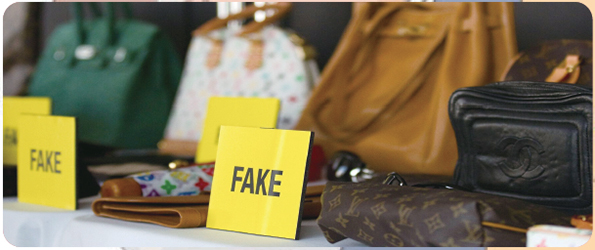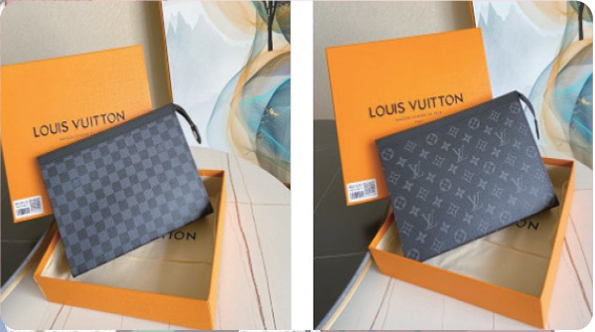Recently, an influencer who appeared in a popular show, presented on one of the OTT services, got into an issue about consuming illegal fashion replicas. Her bracelet and bags seemed similar to widespread imitations of genuine products, and some of them turned out to be imitations through authenticity tests. The case quickly became a hot potato because she was a famous YouTube influencer with a huge number of followers, and she had an abundance of luxury hauls. In addition, she represented herself as a silver spoon living in a deluxe apartment often splurging on shopping luxuries. Later, she admitted her wrongdoing, and apologized for buying and making videos with imitations. She stated that she bought them because they were pretty and didn’t look like replicas.However, it means that fake products are highly exquisite and hard to distinguish from the genuine. It also alludes to the fact that there is already a big replica market even though it is illegal.
[Increasing Sales Figures of Luxury items, Also Including the Knockoffs]
‘Jjaktung’ refers to deceiving with fake, imitation, or replica items. Literally, it is to make fake products which are similar to the original brand. Instead of the words fake and imitation, ‘Jjaktung’ began to be used a lot, and it was registered in advance as a new word. As a result, 'Jjaktung' was universally used more than other synonym. Replica refers to a licensed, official organization-sold imitation like an athlete's uniform, but 'Jjaktung' alludes to a market situation in which an absurd number of illegal fakes are common.
Recently, consumption of luxury brand products has increased significantly in the aftermath of COVID-19. As a result, sales of luxury goods stores, such as department stores and outlets, also rose. According to Euromonitor's announcement, the size of the domestic online luxury goods market in 2020 was about 1.5957 trillion won, up about 11% from the previous year (1.437 trillion won). The psychology of consuming expensive products can only be explained because opportunities for overseas travel decreased. However, as the consumption of luxury goods increased, the distribution opportunities of fakes also increased proportionally. This is because more and more generations are shopping online as well as in offline stores, and more people are selling fake goods in online shopping malls.
[Knockoff Sales and Purchases]
People can easily find these online knockoff sale markets. First, if anyone searches with keywords such as ‘knockoff’, ‘fake’ or ‘replica sales’ on a website or Social Media, many online shops are found. When sellers write articles with searchable keywords on Social Media, it is easier to ensnare teenagers who have relatively longer screentime than adults. On the other hand, sellers register their fake products as parallel imports on online shopping platforms like Coupang. They look similar, as both sell knockoffs, but there is a definite difference between the two. In the former case, consumers know that the product is fake unlike in the latter case, where the consumers have no way to figure out whether the goods are fake or genuine until they receive the parcel.
Articles and accounts advertising fake shopping malls with hashtags like #replica or #replicashop are showing up without being filtered out on Social Media. Through these kinds of posts, the account owner leads people to see that many other users view and buy their products, and thus entice them to buy. These fake markets are proud of the price of their products, which are cheaper than others. It can be possible because they are using direct import from Chinese factories without a middle man and retail margin. Also, they claim to be proud of their materials and accessories which are either identical or tremendously similar to genuine products even though it is really fake.
On the other hand, parallel import is a legitimate method by an individual, other than an official retail company, with rights to import into the country. However, as initially stated, fraudsters that make a sales page for authentic-looking products, advertising original products and sending knockoffs, are increasing. When original goods are sold domestically, the official retailers do not make a price differential although there was a huge exchange fluctuation. Yet, consumers take the opportunity when the exchange dramatically fluctuates to buy high-priced products via parallel imports for a cheaper price than on offer at the official store. Fraudsters use this point adroitly to sell counterfeits. They are generally sold on E-commerce platforms like Coupang or Naver Smart Store. Because consumers do not know whether the item is fake or not, until they receive the actual parcel, it is hard to notice even though they got scammed.
[Reason Consuming Counterfeits Consistently]
Online counterfeits shops mostly sell a variety of products like bags, belts, watches, and accessories. Compared to the price of original goods, counterfeits are at least 60% to 90% cheaper. Prices of items differ by type, design, and brand, but most of them are not over 1,000,000 won. In the actual reviews of people who bought from the shop, most comment “It was a full box with dust bag, warranty card and receipt”, “It really looks like the genuine one” and they indicate that they are positive to buy replicas again. One of them says she was jealous of her friend’s new expensive clothes and bought a replica instead. She also mentions “Finishing and details are neat, and make it look like it’s genuine. I’m satisfied with it.” ‘Full box’ is a term that means a fake product with a dust bag, warranty card, and receipt that can convincingly pretend that the fake is as the original. This is one of the reasons why consumers buy fake products even though they already know it is not a genuine one.
An anonymous consumer, Ms. A, with experience buying fake products said that she did not notice the item was fake when she first saw and bought them. She added, “I did not take a careful look to distinguish the fake from the genuine, so they looked like genuine ones. Even the logo looked the same as the originals, so I just bought it.” Ms. A bought various items including clothes, bags, accessories, and decorations. Furthermore, she is positive to buy some more accessories in the future. “Clothes have a delicate and subtle difference in its texture and materials. This fact makes me reluctant to buy replicas again.” she said.
Prof. Lee Jun-young, Dept. Economics and Finance of Sangmyung University, says that the majority of consumers of fake products are MZ generation consumers. He makes the point that “The MZ generation’s consuming fake products stems from a desire to portray a rich image on Social Media and this is leading to conspicuous consumption.” Especially, the syndrome called ‘Flex Consuming,’ based on a passion for showing off expensive and highly rare brand products, such as bags or shoes to the public, and wanting to be recognized, is prompting the purchase of imitations. He added, “Even people with professional and well-paying jobs purchase a lot of fake products. This means buying imitations is not a specific problem of specific generations and social positions.” He ends with the thought that it is worrisome, because the sellers using Social Media markets can deceive other business owners and consumers even causing them to break the law. Also, in some cases, it may even disrupt E-commerce i.e. stores selling genuine products online.
Fake products became a hot issue due to a duped influencer wearing fakes, and because of legitimate apprehension of a large scale of illegal sellers. However, if consumers are not vigilant, keeping their eye on details and brands, they will fall into the same trap. This will have the negative effect of consumers either taking huge economic losses or being participated to expand the illegal fake product market by buying imitations just because they are cheaper. Though it takes tremendous time and effort to eradicate illegal fake products, if both sellers and buyers are alert and careful in trading them, the imitation market will be decreased in a short time.
By Ji Jae-rim
jlim0714@cbnu.ac.kr
By Yoo Gyeong-chan
jg010077@cbnu.ac.kr


 All
All Culture
Culture






 Ji Jae-rim & Yoo Gyeong-chan
Ji Jae-rim & Yoo Gyeong-chan











